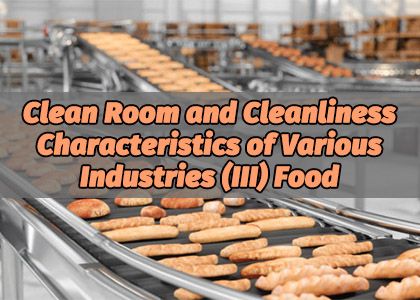
Clean Room and Cleanliness Characteristics of Various Industries (III) Food
Food Industry:
Food is the first necessity of the people. Diseases come in through the mouth, so the safety and health of the food industry in our daily life occupies an important position. Food safety and health mainly to control three aspects: one is to control the standardized operation of production personnel; The second is to control external environmental pollution (to establish a relatively clean operating space. Third, the source of procurement to eliminate problematic product raw materials. The area of food production workshop is compatible with production, the layout is reasonable, and the drainage is smooth; Workshop floor with non-slip, strong, impervious, corrosion-resistant materials, and flat, no water, and keep clean: workshop outlet and connected with the outside drainage, ventilation equipped with anti-rat, anti-fly, anti-insect facilities.
The walls, ceilings and doors and Windows in the workshop are constructed with non-toxic, light-colored, waterproof, mildew resistant, non-shedding and easy to clean materials. Corner, floor Angle, top Angle should have radian (curvature radius should not be less than 3cm). The operation table, conveyor belt, transport vehicle, and equipment in the workshop shall be made of non-toxic, corrosion-resistant, non-rusting, easy to clean and disinfect, and strong materials. An adequate amount of hand-washing, disinfection and hand drying equipment or supplies should be available in appropriate locations, and faucets should be switched on and off manually.
According to the needs of product processing, there should be disinfection facilities for shoes, boots and wheels at the entrance of the workshop. There should be a changing room connected to the workshop. According to the needs of product processing, toilets and showers connected with the workshop should also be set up. In order to prove that the clean food packaging workshop is working satisfactorily, it must be demonstrated that it meets the requirements of the following guidelines:
1. The air supply of the food packaging dust-free workshop is sufficient to dilute or eliminate indoor pollution.
2. The air in the food packaging dust-free workshop flows from the clean area to the area with poor cleanliness, and the flow of polluted air reaches the extent that the air flows in the doorway and indoor buildings in the correct direction.
3. The air supply of food packaging dust-free workshop will not significantly increase indoor pollution.
4. The movement of the indoor air in the food packaging dust-free workshop can ensure that there is no high-concentration gathering area in the chamber. If the clean room meets the requirements of these guidelines, its particle concentration or microbial concentration (if necessary) can be measured to determine that it meets the specified clean room standards.
Food packaging clean workshop test:
1. Air supply and exhaust air volume: if it is a turbulent clean room, then it is necessary to measure the air supply and exhaust air volume. If it is a unidirectional flow clean room, the wind speed should be measured.
2. Air flow control between zones: In order to prove that the direction of air flow between zones is correct, that is, flow from the clean area to the area with poor cleanliness, it is necessary to detect: (1) the pressure difference of each zone is correct: (2) The direction of air flow at the door or the opening of the wall, the floor, etc., is correct, that is, flow from the clean area to the area with poor cleanliness.
3. Filter leak detection: the high efficiency filter and its outer frame should be inspected to ensure that suspended pollutants will not pass through: (1) the damaged filter; (2) The gap between the filter and its outer frame; (3) Other parts of the filter device invade the room.
4. isolation leak detection: This test is to prove that suspended pollutants do not penetrate the clean room through the building materials.
5. Indoor air flow control: The type of air flow control test depends on the air flow pattern of the clean room - whether it is turbulent or one-way flow. If the clean room air flow is turbulent, it must be verified that there are no areas in the room where the air flow is insufficient. If the unidirectional flow clean room, it must be verified that the wind speed and direction of the entire room are in line with the design requirements.
6. Suspended particle concentration and microbial concentration: if these tests meet the requirements, the particle concentration and microbial concentration (if necessary) are measured in order to verify that they meet the technical conditions of the clean room design.
7. Other tests: In addition to the above pollution control tests, sometimes one or more of the following tests must be carried out: temperature; Relative humidity; Indoor heating and cooling capacity; Noise value; Illuminance; The vibration value.